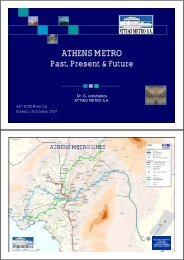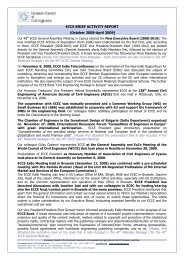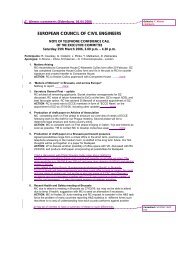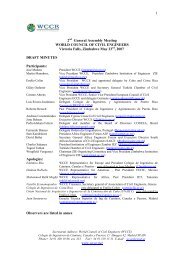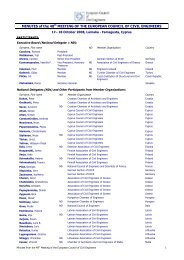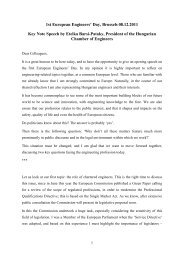A Closer Look at Prevailing Civil Engineering Practice - European ...
A Closer Look at Prevailing Civil Engineering Practice - European ...
A Closer Look at Prevailing Civil Engineering Practice - European ...
You also want an ePaper? Increase the reach of your titles
YUMPU automatically turns print PDFs into web optimized ePapers that Google loves.
A <strong>Closer</strong> <strong>Look</strong> <strong>at</strong> <strong>Prevailing</strong> <strong>Civil</strong> <strong>Engineering</strong> <strong>Practice</strong>, Wh<strong>at</strong>, Why and How<br />
Vincent T. H. CHU<br />
14. Wh<strong>at</strong> is the significance of isol<strong>at</strong>ion joints<br />
Isol<strong>at</strong>ion joints isol<strong>at</strong>e slabs or concrete structure from other parts of<br />
structure. The presence of isol<strong>at</strong>ion joints allows independent vertical or<br />
horizontal movement between adjoining parts of the structure. Otherwise,<br />
the structure may experience cracking owing to the restrained movement<br />
caused by directional connection between adjoining concrete structures.<br />
15. Wh<strong>at</strong> are the reasons of occurrence of dusting and scaling of<br />
concrete surface<br />
Dusting refers to the form<strong>at</strong>ion of loose powder arising from the<br />
disintegr<strong>at</strong>ion of concrete surface. For dusty concrete surface, they can<br />
be easily scr<strong>at</strong>ched by nails. The cause of dusting can be rel<strong>at</strong>ed to<br />
finishing works carried out before completion of concrete bleeding. The<br />
working back of bleeding w<strong>at</strong>er to concrete surface produces a low<br />
strength layer with high w<strong>at</strong>er cement r<strong>at</strong>io. It may also arise owing to<br />
inadequ<strong>at</strong>e curing and inadequ<strong>at</strong>e protection of freshly placed concrete<br />
against rain, wind and snow.<br />
Scaling is the occurrence of peeling of hardened concrete surface as a<br />
result of freezing and thawing effect. Scaling occurs in non-air-entrained<br />
concrete as air entrainment is normally adopted to protect concrete<br />
against freezing and thawing. Spaying of sodium chloride deicing salts is<br />
also another common cause of scaling.<br />
16. Wh<strong>at</strong> is the purpose of adding polyethylene film in interior slabs<br />
sitting on grade for building structures<br />
Membrane m<strong>at</strong>erials, such as polyethylene film, are commonly used to<br />
reduce vapour transmission from soils to concrete slab. They are often<br />
termed “vapour retarder” and are placed on the underside of concrete<br />
slabs sitting directly on soils for building structures. Protection from<br />
moisture is essential because floors inside buildings are normally covered<br />
with carpet and tiles and penetr<strong>at</strong>ion of w<strong>at</strong>er vapour through concrete<br />
slabs could result in the failure of adhesives in tiling, discolor<strong>at</strong>ion of<br />
flooring products and fungal growth.<br />
17. Should on-site addition of w<strong>at</strong>er to fresh concrete be allowed<br />
The addition of w<strong>at</strong>er to fresh concrete in truck mixer upon arrival <strong>at</strong> the<br />
loc<strong>at</strong>ion of concrete is allowed only if some design mixing w<strong>at</strong>er is held<br />
19






